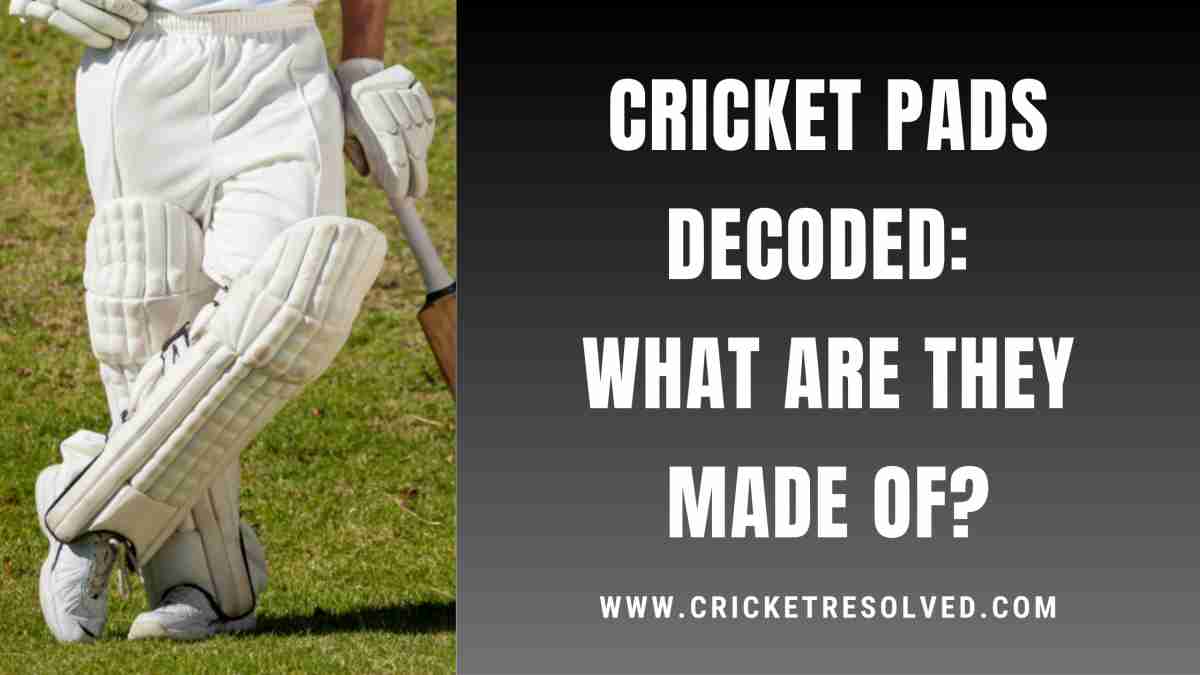
Cricket, the game of passion and strategy, demands the utmost protection for its players. When it comes to batting, the cricket pads come into play.
These essential gears shield the batter’s legs from the onslaught of fast deliveries. But have you ever wondered what cricket pads are made of? Let’s uncover the materials used to make these protective pads.
Why do Batters Use Cricket Pads?
Imagine facing a bowler bowling at you with blistering speed. As a batter, your legs are vulnerable to injury from the impact. That’s where cricket pads come to the rescue!
They act as a shield, reducing the risk of injuries from those swift deliveries. With pads on, batters can focus on their shots with confidence and minimize the chances of getting hurt.
Traditional and Modern Cricket Pads
Traditional Cane Pads
Cricket has been played since the 1500s. But players played the game without the batting pads.
The first instance of using batting pads dates back to the mid-1700s in England. Since then, the protective gear has been an integral part of the game.
The traditional pads designed during the 19th and early 20th centuries included materials such as cane, leather, and soft fabric. Furthermore, players referred to these pads as skeleton pads.
The cane acted as a shield around the shin (front of the leg). The exterior shell had a leather coating, while they used soft fabric inside the pads.
Modern Cane Pads
The method of manufacturing modern cane pads is similar to the traditional method.
In the traditional method, only cane sticks formed the shell. Now, this has gone one step ahead.
To provide extra protection, manufacturers stuff the shell with cotton. This gives it a cushion-like feel and a robust look.
High-Density Foam Pads
The high-density foam pads are also similar to the modern cane pads but without the cane sticks.
The outer shell of these pads is crafted from synthetic materials like high-density foam. Inside the pads, you’ll find soft foam or cushioning materials that provide comfort.
Adjustable straps made of elastic or sturdy fabric secure the pads in place, allowing players to move freely without compromising their safety. Besides, the major reason for using these pads is that they are lighter than modern pads.
Materials used to make cricket pads
Cricket pads are designed to strike a balance between protection and flexibility. They consist of various materials carefully chosen for their durability and impact-absorbing properties.
Cane Sticks
These wooden cane sticks shield the batter’s leg and offer firm support to the pads. And they are also available in ample quantities.
Leather
Leather is durable and acts as a good resistance against hard cricket balls. However, lighter, cheaper, and more durable materials have replaced leather in modern pads.
PVC
The more durable PVC has replaced the leather. Its cost is affordable, and it is also easy to clean.
Cotton
Cotton is often used in cricket pads to give them a cushion-like finish. It is capable of absorbing the impact of the ball and protecting the legs of the batter.
High-Density Foam
High-density foams are used in modern pads. They are lightweight, which ensures quick running between the wickets And they can absorb the impact of the ball pretty well.
Types of cricket pads
Cricket pads come in different types to cater to the specific needs of players. Here are a few notable variations:
Batting Pads: These are the most common pads used by batters. Batting pads cover the lower legs, shins, and knees, offering vital protection while allowing batters to move swiftly.
Wicket-keeping Pads: Wicket-keepers have a unique role in cricket, and their pads are designed accordingly. Wicket-keeping pads prioritize flexibility and quick reflexes while still providing ample protection to the lower legs.
Close-in Fielding Pads: Fielders stationed near the batter wear specialized pads to safeguard vulnerable areas like the thighs and inner legs. These pads are tailored to ensure protection during close catches and quick stops.
Also Read: The Cricket Fielding Positions – Explained
Conclusion
Cricket pads are an essential part of a cricketer’s gear, providing the necessary protection for batters and fielders. Crafted with durable synthetic materials, these pads absorb the impact of the cricket ball while allowing players to perform at their best.
Cricket pads play a crucial role in the game, keeping players safe and confident on the field. Next time you watch a thrilling cricket match, take a moment to appreciate the significance of these protectors.
Read Next: What is the Weight of a Cricket Bat?



Comments (5)
Arm Sleeves: Why Do Cricketers Wear Them? - Cricket Resolvedsays:
June 21, 2023 at 10:28 am[…] Read Next: Cricket Pads Decoded: What Are They Made of? […]
Exploring the Similarities and Differences Between Cricket and Baseball - Cricket Resolvedsays:
July 2, 2023 at 11:03 am[…] baseball differs significantly. Cricket players use a bat, ball, protective gear (such as helmets, pads, and gloves), and wickets. Baseball players use a bat, ball, glove, and protective gear (such as a […]
How to Swing a Cricket Ball? - Types & Variations of Swing Bowling Explained - Cricket Resolvedsays:
July 6, 2023 at 10:39 am[…] Also Read: Cricket Pads Decoded: What Are They Made of? […]
How is a Cricket Ball Made? Step-by-Step Process - Cricket Resolvedsays:
July 11, 2023 at 12:57 pm[…] owes its charm to the intricacies of its equipment, like the bat, ball, gloves, and pads. Among them, the humble cricket ball takes center stage, dictating the course of the […]
How to Apply a Toe Guard to a Cricket Bat? - Cricket Resolvedsays:
September 24, 2023 at 11:32 am[…] bats, like the players themselves, require some safeguarding. A toe guard is a frequent form of protection. This is a piece of […]